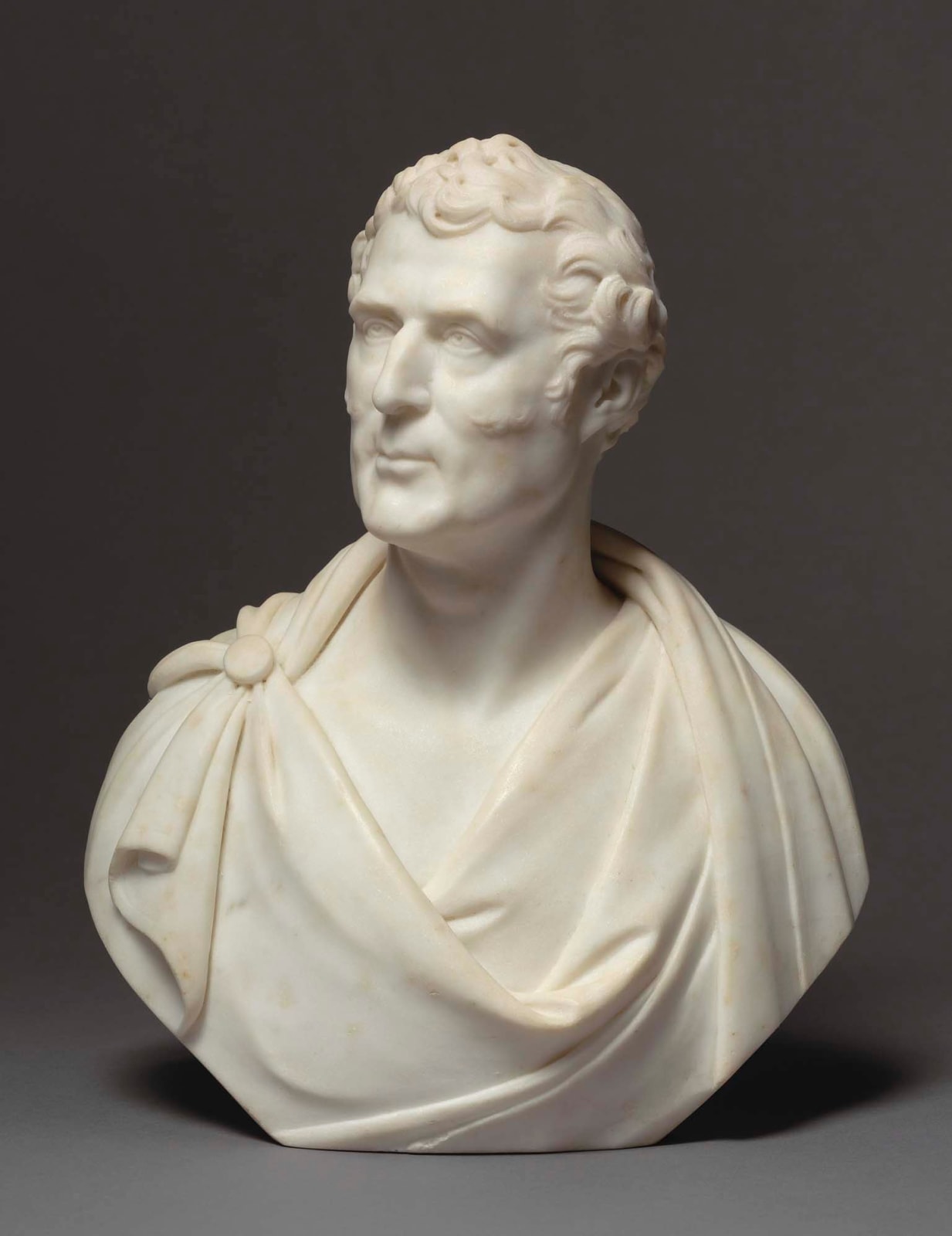
John Francis
Portrait of the Duke of Wellington, 1830
Marble
12 inches (30.5 cm) high
Philip Mould & Co.
To view all current artworks for sale visit philipmould.com This cabinet or library bust, the term given to small marble busts, is almost certainly that exhibited by John Francis...
To view all current artworks for sale visit philipmould.com
This cabinet or library bust, the term given to small marble busts, is almost certainly that exhibited by John Francis at the Royal Academy in 1830. Francis, a pupil of Chantrey, was one of the mid nineteenth century’s best known portrait sculptors, and regularly exhibited portraits of royalty and leading statesmen at the Academy. The original Academy catalogue states that Francis entered a ‘Miniature marble bust of the Duke of Wellington’ in 1830, the only occasion on which he exhibited a bust on that scale at the Academy during his career. Although this portrait is known in at least one other version – a full size bust of the same date at Woburn Abbey – the present bust is the only known example on a scale that could be called ‘miniature’.
Francis regularly portrayed the Duke of Wellington. His 1832 bust was also exhibited at the Royal Academy, and is now at Stratfield Saye, Wellington’s country estate; while in 1838 he exhibited a ‘colossal’ bust of the Duke. A posthumous bust was exhibited in 1853, a year after Wellington’s death. The present bust was made while Wellington was Prime Minister. In 1828 the Duke had been called upon to form an administration after the collapse of the short-lived administration, of Lord Goderich, who had failed to form a government after the death of George Canning. The situation called for a figure of national standing, and Wellington, as the ever popular victor of Waterloo and the Peninsular Campaign, was chosen by George IV to form a Tory government. Robert Peel was to be Wellington’s party leader in the Commons, and a number of able young peers, such as the future Prime Minister Lord Aberdeen, joined the government.
Wellington’s political career, however, was hardly as successful as his military one had been. Perhaps understandably, a man used to giving orders and receiving unquestioned obedience in the army found it hard to accept a world that required consensus and political compromise. He quickly proved himself to be a reactionary Tory when the political times, amidst growing unrest over Catholic emancipation and the pressure for electoral reform, really required a fleet-of-foot Whig. After almost three years in office, he was forced to resign after losing a crucial vote in the House of Commons in November 1830.
This cabinet or library bust, the term given to small marble busts, is almost certainly that exhibited by John Francis at the Royal Academy in 1830. Francis, a pupil of Chantrey, was one of the mid nineteenth century’s best known portrait sculptors, and regularly exhibited portraits of royalty and leading statesmen at the Academy. The original Academy catalogue states that Francis entered a ‘Miniature marble bust of the Duke of Wellington’ in 1830, the only occasion on which he exhibited a bust on that scale at the Academy during his career. Although this portrait is known in at least one other version – a full size bust of the same date at Woburn Abbey – the present bust is the only known example on a scale that could be called ‘miniature’.
Francis regularly portrayed the Duke of Wellington. His 1832 bust was also exhibited at the Royal Academy, and is now at Stratfield Saye, Wellington’s country estate; while in 1838 he exhibited a ‘colossal’ bust of the Duke. A posthumous bust was exhibited in 1853, a year after Wellington’s death. The present bust was made while Wellington was Prime Minister. In 1828 the Duke had been called upon to form an administration after the collapse of the short-lived administration, of Lord Goderich, who had failed to form a government after the death of George Canning. The situation called for a figure of national standing, and Wellington, as the ever popular victor of Waterloo and the Peninsular Campaign, was chosen by George IV to form a Tory government. Robert Peel was to be Wellington’s party leader in the Commons, and a number of able young peers, such as the future Prime Minister Lord Aberdeen, joined the government.
Wellington’s political career, however, was hardly as successful as his military one had been. Perhaps understandably, a man used to giving orders and receiving unquestioned obedience in the army found it hard to accept a world that required consensus and political compromise. He quickly proved himself to be a reactionary Tory when the political times, amidst growing unrest over Catholic emancipation and the pressure for electoral reform, really required a fleet-of-foot Whig. After almost three years in office, he was forced to resign after losing a crucial vote in the House of Commons in November 1830.
Provenance
American Private Collection5
of
5